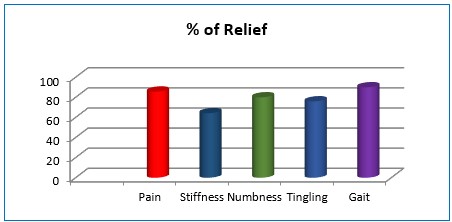Clinical evaluation of Nirabhishankita Basti Karma administered by three piecemeal Putak - A Pilot Clinical Study
DOI:
https://doi.org/10.21760/jaims.8.11.6Keywords:
Nirabhishankita Basti, three piecemeal Putaka, Ruja, Pain, Niruha BastiAbstract
Background: Pain has globally become an attention problem which causes discomfort by affecting the body as well as the mind. Pain (Ruja) is the cardinal feature of most of the musculoskeletal disorders and it can be affect the quality of life. In Ayurveda all types of pain are under the umbrella of Vata which is the prime for generating and spreading the pain. Basti is given more importance because it directly pacifies the vitiated Vata Dosha. Aim and Objective: To evaluate the efficacy of Nirabhisankita Basti Karma administered by three piecemeal Putak. Materials and Methods: Randomly selected 5 patients were examined on the ground of Astavidha Pariksha (eight-fold examination) and specially prepared data research questionnaire. Selected subjects were administered with three piecemeal Putak Basti for 3 days and it was followed up of 15 days. Assessment was done through various variables like pain, stiffness, numbness, tingling, and gait. Results: The study showed that Nirabhisankit Basti produced an extremely significant improvement in pain and gait with 85.7 & 90 percentage reliefs while very significant in stiffness, numbness and tingling. Conclusion: Nirabhisankit Basti is found to be effective in musculoskeletal pain.
Downloads
References
WHO. Musculoskeletal Conditions. World Health Organization. https://www.who.int/news-room/fact-sheets/detail/musculoskeletal-conditions. Published 2019. Accessed July 17, 2020.
Smith E, Hoy DG, Cross M, et al. The global burden of other musculoskeletal disorders: estimates from the Global Burden of Disease 2010 study. Ann Rheum Dis. 2014;73:1462–1469.
Acharya Sushruta. In: Susruta samhita. Shastri K., editor. chaukhambha Sanskrit sansthana; Varanasi: 2014. Sutrasthana;
Shastri Kashinath, Chaturvedi Gorakhnath edited Charak Samhita of Agnivesha, revised by Charaka and Dridhbala; siddhi sthana, ch.1, verse 39, vol. 2, Varanasi; Chaukhambha Bharati Academy, Reprint Ed,; 2018; p.971
Bhavaprakasha saṁhita, Madhyam khanda ed. Shastri Girijashankar Mayashankar, Sastu Sahitya, Ahamadabad, Edition 1982.
Subina et. al. Understanding the mode of action of bastikarma (medicated enema). AAMJ 2015; 1: 267-74
Hannibal KE, Bishop MD. Chronic stress, cortisol dysfunction, and pain: a psychoneuroendocrine rationale for stress management in pain rehabilitation. Phys Ther. 2014 Dec;94(12):1816-25. doi: 10.2522/ptj.20130597. Epub 2014 Jul 17. PMID: 25035267; PMCID: PMC4263906.
McBeth J, Chiu YH, Silman AJ, Ray D, Morriss R, Dickens C, Gupta A, Macfarlane GJ. Hypothalamic-pituitary-adrenal stress axis function and the relationship with chronic widespread pain and its antecedents. Arthritis Res Ther. 2005;7(5):R992-R1000. doi: 10.1186/ar1772. Epub 2005 Jun 17. PMID: 16207340; PMCID: PMC1257426.















